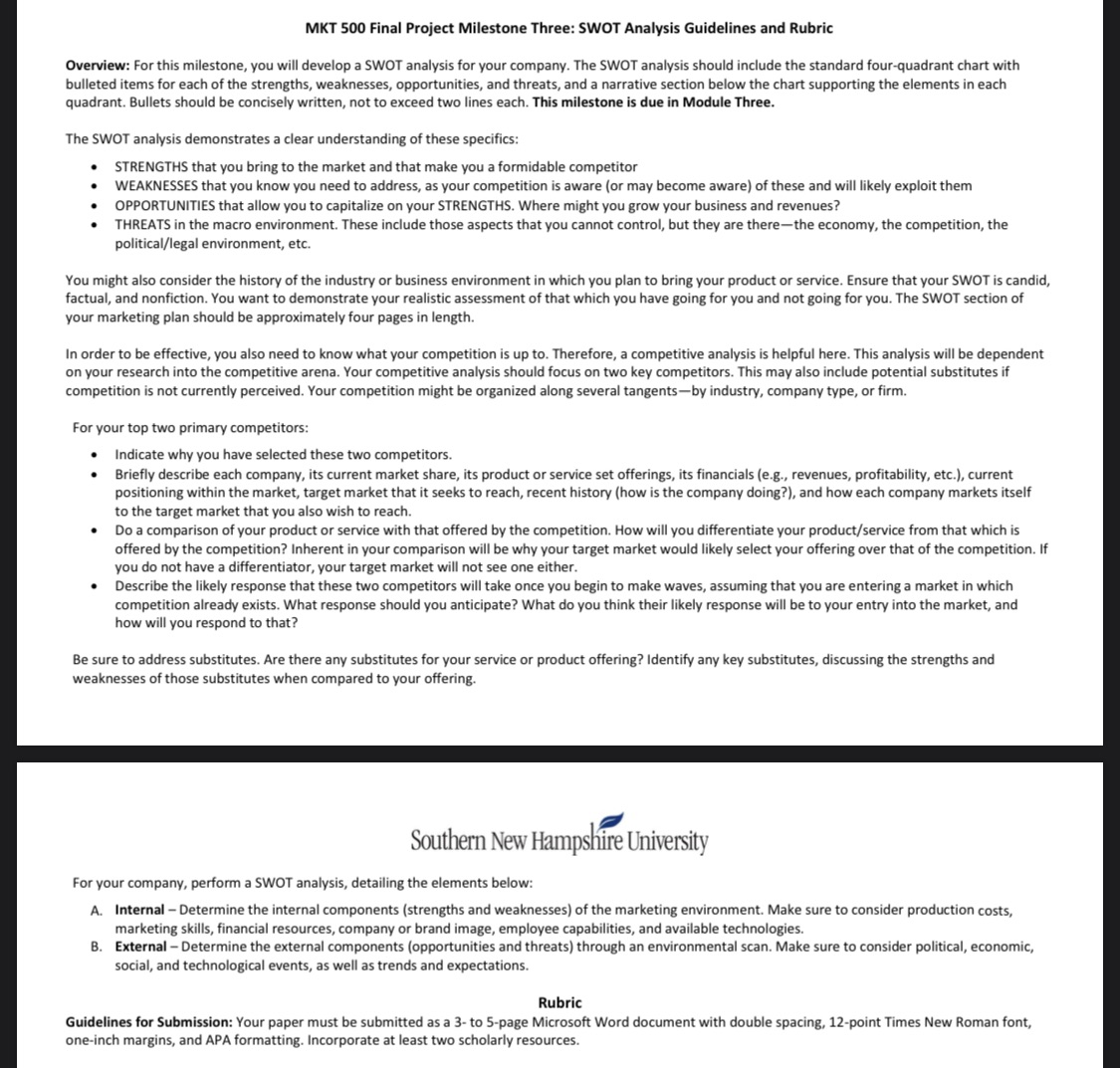Develop SWOT analysis for a business?
MKT 500 Final Project Milestone Three: SWOT Analysis Guidelines and Rubric Overview: For this milestone, you will develop a SWOT analysis for your company. The SWOT analysis should include the standard four-quadrant chart with bulleted items for each of the strengths, weaknesses, opportunities, and threats, and a narrative section below the chart supporting the elements in each quadrant. Bullets should be concisely written, not to exceed two lines each. This milestone is due in Module Three. The SWOT analysis demonstrates a clear understanding of these specifics: STRENGTHS that you bring to the market and that make you a formidable competitor WEAKNESSES that you know you need to address, as your competition is aware (or may become aware) of these and will likely exploit them OPPORTUNITIES that allow you to capitalize on your STRENGTHS. Where might you grow your business and revenues? THREATS in the macro environment. These include those aspects that you cannot control, but they are there-the economy, the competition, the political/legal environment, etc. You might also consider the history of the industry or business environment in which you plan to bring your product or service. Ensure that your SWOT is candid, factual, and nonfiction. You want to demonstrate your realistic assessment of that which you have going for you and not going for you. The SWOT section of your marketing plan should be approximately four pages in length. In order to be effective, you also need to know what your competition is up to. Therefore, a competitive analysis is helpful here. This analysis will be dependent on your research into the competitive arena. Your competitive analysis should focus on two key competitors. This may also include potential substitutes if competition is not currently perceived. Your competition might be organized along several tangents-by industry, company type, or firm. For your top two primary competitors: Indicate why you have selected these two competitors. Briefly describe each company, its current market share, its product or service set offerings, its financials (e.g., revenues, profitability, etc.), current positioning within the market, target market that it seeks to reach, recent history (how is the company doing?), and how each company markets itself to the target market that you also wish to reach. . Do a comparison of your product or service with that offered by the competition. How will you differentiate your product/service from that which is offered by the competition? Inherent in your comparison will be why your target market would likely select your offering over that of the competition. If you do not have a differentiator, your target market will not see one either. Describe the likely response that these two competitors will take once you begin to make waves, assuming that you are entering a market in which competition already exists. What response should you anticipate? What do you think their likely response will be to your entry into the market, and how will you respond to that? Be sure to address substitutes. Are there any substitutes for your service or product offering? Identify any key substitutes, discussing the strengths and weaknesses of those substitutes when compared to your offering. Southern New Hampshire University For your company, perform a SWOT analysis, detailing the elements below: A. Internal - Determine the internal components (strengths and weaknesses) of the marketing environment. Make sure to consider production costs, marketing skills, financial resources, company or brand image, employee capabilities, and available technologies. B. External - Determine the external components (opportunities and threats) through an environmental scan. Make sure to consider political, economic, social, and technological events, as well as trends and expectations. Rubric Guidelines for Submission: Your paper must be submitted as a 3- to 5-page Microsoft Word document with double spacing, 12-point Times New Roman font, one-inch margins, and APA formatting. Incorporate at least two scholarly resources







